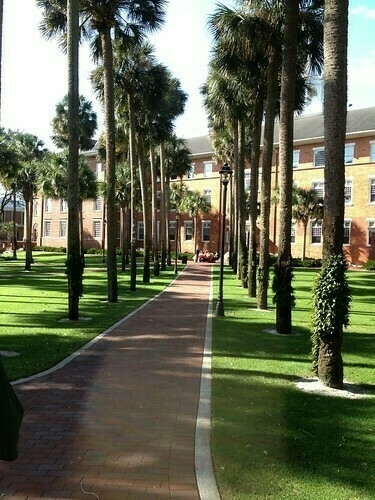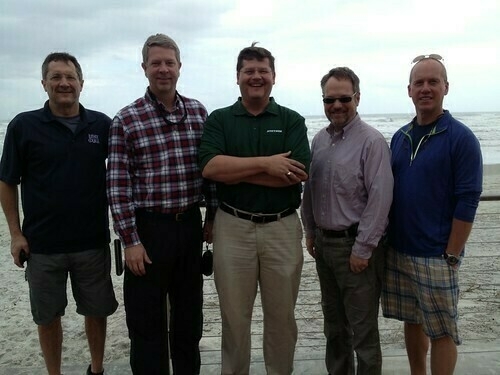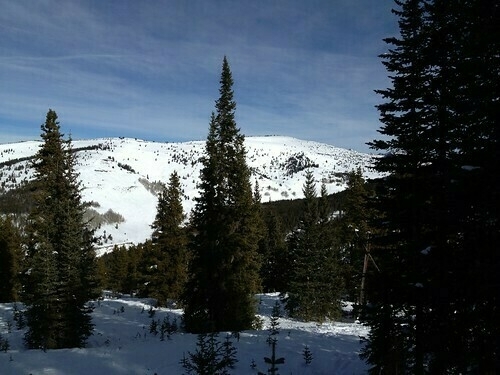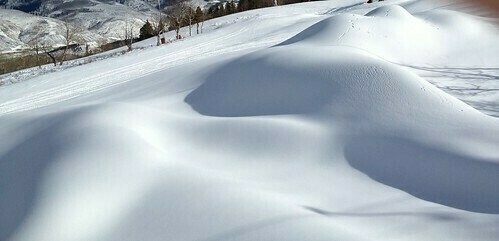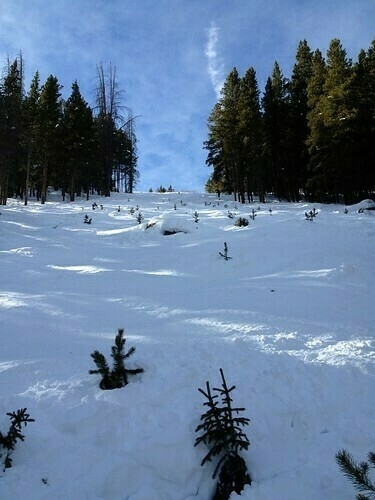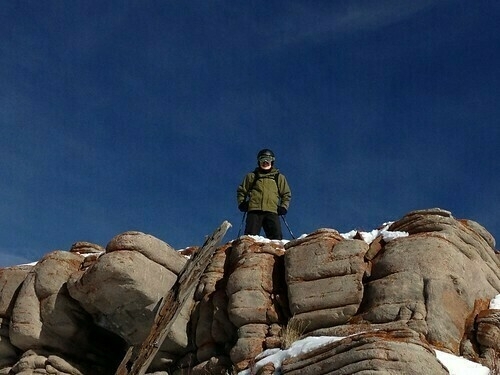Category: article
You are viewing all posts from this category, beginning with the most recent.
the debary institute
Its been a great J-Term. A trip to Vail for some Skiing, and a trip to Florida to solve the worlds problems with great friends at the DeBary Institute. For those who do not know, the DeBary institute is a newly renowned think tank with roots in the Bone Lake Global Institute.
We arrived on Friday and spent a wonderful late afternoon enjoying the hospitality and home of our host, Tim Peter.
On Saturday we toured Stetson University in the morning.
Later we repaired to Smyrna Beach, it was a bit windy but we enjoyed it all the same.
The culinary highlight of our trip was dinner at the Swamp House Grill and Tiki Bar. We enjoyed some lovely alligator bites as appetizers:
 (Yes, as the famous frog said, they do taste like chicken)
(Yes, as the famous frog said, they do taste like chicken)
After dinner we sat around enjoying the music of Mark Moore.
Sunday was Football (European and American) and then Golf day.
Dinner was provided by Gregory and Brad who made a charming seafood alfredo.
Monday morning we left the house at 5:50AM. The temperature was 62 degrees. Five hours later we arrived in Cedar Rapids where the temperature was -2. Thats a big swing for a monday morning.
Already looking forward to next year!
everyday python - new blog
I've decided that it will be best to keep my personal blog separate from the new Everyday Python blog project. All of the infrastructure to make the posts interactive just work so much better when I have control of the server and everything else. So You can head over to Everyday Python and click on the Everyday Python link there, or if you want to subscribe to the RSS feed for that project you can use this link.
vail 2013
I just got back from four awesome days of skiing in Vail and Beaver Creek.
The Colorado resorts have a really cool new way of handling the ski passes, instead of clipping a tag on your jacket you now get a credit card with an RFID chip in it. Talk about a ski pass that appeals to the Geek in me! But whats even better is that every time you go on a lift, there is an RFID reader that grabs your ID and logs that lift ride. So now at the end of the day you can go on to a website and see how many vertical feet you skiied that day. Very cool. Over our four days of skiing we did just over 95,000 vertical feet! If we'd only known how close to 100k we would get we surely would have had a shorter lunch break on day one!
Since snow started late and has been a bit sparse since Christmas there was a lot of snow making going on. The mounds of snow created by the snow machines remind you of a Dr. Seuss drawing:
I'm pleased to say that my skiing has really improved thanks to my Solomon BBR 8.9 skis. I've started to call them my magic skis because I can even do the moguls! Here's a picture I took of craig at the top of one particularly narrow and moguly run. Note that I got down first with enough time to turn around and snap some pictures.
Here's another shot of Craig just before he jumped off the cliff. Note once again who went first to take the picture: :-)
All in all it was a great four days of skiing with the guys. Can't wait until next year.
generating a password - part 1
OK, here is the first installment of the new Everyday Python series. Today I'm just providing a link, as I still have some infrastructure work to get done in order to publish each installment both here and at Runestone Interactive.
introducing everyday python
Everyday Python¶
It is always risky to make your New Years resolutions public, but this is one I’ve
been thinking about for a while now, and so I’m going to go ahead and impose a
measure of accountability on myself by proclaiming this publicly. This week, I’m
starting a series of educational blog posts here, and as a part of my Runestone
Interactive publishing project.
My idea is to publish a series of Python programming projects, aimed at solving
everyday problems, or puzzles. Hopefully these little projects will be interesting
and will give learners motivation to dig into the details of the solutions. I
will provide links to the relevant Python programming constructs and data types in
either of the two interactive books (How to think like a computer scientist:
Interactive Edition , or
Problem Solving with Algorithms and Data Structures using Python) This will let me
focus on the problems, and not the minutia of the language. Lets face it, reading
about all the different possible string methods is not that exciting, but seeing
them in action, and then wondering about what else you might be able to do with
strings is OK.
The great thing about Python is that if you write things in a straightforward
manner its pretty easy to follow even if you don’t know all the details. So, that
is my intention. Write a solution and do it in straightforward Python that
beginners can understand. Each project will appear over several days, and
will likely include some homework related to the project. I’ll provide the solution
in a followup post. In addition, I may refine the solution over the course of
several days introducing more and interesting solutions or more advanced features
of the Python language.
In the back of my mind I am drawing inspiration from the old Communications of the ACM column by John
Bently called Programming Pearls In John’s columns he would feature a particular
problem or algorithm, and present it in a straight forward way, but then he would
refine that solution again and again polishing it until he had an incredibly
elegant solution. It was beautiful because even a novice programmer could
understand what was going on at the start of the article, but would get sucked in
to the beautiful solution and would learn more than they thought possible. While
advanced programmers might chuckle at the initial solutions, even they would have
to admit that they learned something by the end of each column.
I already have a few ideas in mind for the first few projects. I’m going to try
to start fairly easy with some string and list kind of projects, and work my way up
to more complex problems and algorithms, again this is meant to be educational so
that in theory a beginner might read through these posts more or less
chronologically, and learn some computer science along the way.
Click the title to leave a comment.
euchre etiquette
How do you know you have an enduring friendship? When after more than 27 years as friends, and seven days of traveling together you can play Euchre – couple against couple – and still be friends at the end of the train ride from Seward to Anchorage. Now you might think that a simple card game means nothing, but there a few members of our party of 4 who are a little on the competitive side.
The controversy in this story came after our third missed bear siting on the train. “There’s a bear up ahead on the left side of the train… No now its on the right… no, now its on the left…” This is some kind of weird plan by the conductor to get the train rocking back and forth, or something to get the people in the back cars of the train to drink more. So, here it is dear readers, as we are all in a state of frustration over bear sitings, the up card is a heart, I’m holding three diamonds (but no bowers). Everyone passes, and it comes back around to me. I bid diamonds. This is when the trouble starts. As it turns out, Holly has both red bowers and only passed because she had better diamonds than hearts. Needless to say we get set, and I launch into some kind of self righteous tirade about “maur passing” just to set us. This scenario plays itself out three times again over the course of the train ride… Now last night I might have said some mean words about Holly’s card playing ethics, but today in hindsight, and in the spirit of type 2 fun, I can see that I might have been overly harsh in my judgement.
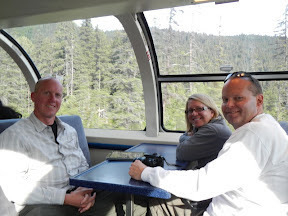
The card playing on the train was the culmination of a long day. The last day of a cruise is always a long hard day. For one thing, I think thats one of the things that all cruise lines suck at. You are an awesome person who must be waited on and pampered at every turn, until the last morning of the cruise. Then you yesterday’s news, who must get up early and off the ship as soon as possible, so your room can be turned over to someone new and wonderful who must be pampered at every turn. Or maybe I’m just grumpy that I’m not the new wonderful person anymore. In any case we love cruising and its ability to allow you to see great places in the world, all the while knowing that you have a safe comfortable place to eat and sleep each night.
We spent our day on a Kenai Fjord tour. We had another day of wildlife sitings. The new animals we saw today included Dahl Porpoises and up close views of Puffins and Stellar Sea Lions. The tour company was really good, it was Major Marine Tours. Its not the largest tour company in the marina but the service can’t be beat. When we got out into open ocean areas and the swells got large they were especially kind to the large number of people at the back railing “going for distance."

As I post this picture of the sea lions – whose population has been declining for the last several years – I am reminded of one especially redeeming quality of the day. SUN!! This is the first day since we left Minneapolis that we’ve had a sunny day.
After a long day, we arrived at the Anchorage train station at 10:30 PM. We got our luggage and the hotel shuttle picked us up for our ride to the hotel. Holly and I transported all of our bags to our room, while Jane and Brian stayed on the shuttle to go to the airport to get our car. We lucked out on the emerald aisle and got a good sized Dodge. At least its big enough to hold all of our luggage and all of us. We had envisioned a number of scenarios in which we stored our luggage at the hotel while we went North to Denali.
As I write this we are in our room in the Mckinley Creekside Cabins. Its not quite the same as our cabin on board the ship, but as Gabe would say, in Alaska, “Warm and Dry is more than you can hope for” We had a pretty good drive in the rain to get here, including a swell stop at the liquor store in Wasilla, and some fake pictures of where we imagine Sarah Palin might have lived. We got our tickets for tomorrows bus tour of Denali and then spent some time visiting with the sled dogs of Denali. We took the very scenic Rock Creek hiking path back to the visitors center and then headed out to Prospectors Pizza for a delicious meal.
Tomorrow will be another long day of hiking and bus riding as we go in search of Bear and Moose here in Denali National Park. We are hoping for another clear day so that we can see Mount McKinley.
- Posted using BlogPress from my iPad
Location:Alaska
icy strait / hoonah
I mentioned type 3 fun in a previous posting, and although there was plenty of type 1 fun to be had in Icy Strait I’d like to begin this post with a little description of some type 3 fun. As a reminder, the definition of type 3 fun is something that is lame when you do it, and remains lame and not fun even in the retelling. Thus was our bike tour of Hoonah.
I should start out by saying that it is not the fault of the bike tour guide, or anyone else involved with tours at Icy Straits. We signed up for the bike tour / zip line combination tour through the cruise line because that was the only way we could sign up for a zip line tour in the afternoon. The idea of an eight mile bike ride sounded appealing, a bike tour is a great way to see an area at a faster pace than walking, and is a nice way to get to know an area better than you do in a tour bus. but, the simple truth is that Hoonah is a nice small fishing town in Alaska, but there really isn’t that much to see. So, we saw the ferry terminal (3-4 ferries per week), the office bar, the seaplane dock, the library, the post office, and the airport. Oh yeah, and it was RAINING yes really really raining. We were absolutely soaked to the bone through our pants and jackets and everything. Yuck!
We all agreed that what we should have done was just not ride the bikes. We could have stayed at the visitor center for a while staying warm and dry and then gotten on the bus to the top of the zip line. Our mistake. So, yes a wet cold bike ride through a town of 800 is virtually the definition of type 3 fun.
But, lets leave that in the past and talk about the highlights of our day in Icy Strait.
It began in the morning with our whale watching adventure. We had booked a small tour with a private operator. I would highly recommend that everyone does this. The small boats are so much more nimble, and you get to know some of the local people in a way that you can’t when you are on a big boat with 100 other people. So it happened that there were only six of us on the boat with captain Floyd. We had plenty of room to spread out and we were not vying for position with other people when the whales showed up.
As whale watching trips go, this one just couldn’t be beat. We were not even out of the harbor before we were treated to a humpback bubble netting. Bubble netting is one feeding strategy used by the humpacks. They circle under the water making tons of bubbles that confuse the smelt to the point where they don’t know which way is up. Then the whale swoops in from below with mouth wide open and scoops up hundreds of gallons of water and fish. The whale closes its mouth and strains out all the yummy fish through its baleen. Here’s a picture of the first whale we encountered.
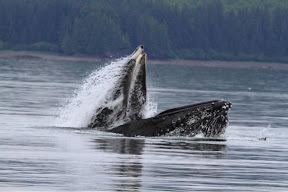
Now, of course, anyone who has ever been on a whale watching trip has seen lots of whale tails. As the humpbacks typically come up, show their hump for a while, and then dive deep. When they dive deep they do so with their tail straight up in the air. What most people do not get the opportunity to see first hand is a humpback breaching. This is when the whale propels its whole body out of the water. This is an amazing feet for an animal that averages 40 feet in length and weighs about 1000 pounds per foot of length!
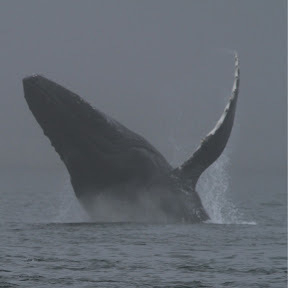
We were lucky enough to see several such breaches. I was lucky enough to have my camera pointed in the right direction when this one happened!
Finally, we were in for one more bonus. Orcas! Its pretty rare to get to see Orcas on a whale watching trip! After watching the humpbacks for a while our captain informed us that there were Orcas in the area. This is another great example of the benefit of going on a smaller ship. The captain can just take off and follow the whales you want to see.

Here are two Orcas from the small pod we were following. For a while we thought we were going to see the death of one of the sea lions swimming perilously close to this group, but I guess they were not hungry at the time. The dorsal fin in the picture above is about six feet tall!
So, the whale watching was awesome, but our final act of the day was also a real blast. The worlds longest, highest, fastest zip line! Its a one shot ride from the top of the mountain outside of hoonah, down to sea level. This was really a stretch for Holly, who is a not a lover of heights, but the ride was fun. Unlike other zip lines, this one actually has a harness that allows you to sit quite comfortably. You don’t have any brakes to worry about as that is taken care of for you at the bottom by Physics.
At the top of the zip line you brace your feet against the starting gate, six people at a time, and then they count down from three. The gates open and you are off. In our case we started out in the clouds, flying downward. Suddenly you are out of the clouds and the ship and the water all come into beautiful view right in front of your eyes. In just about 90 seconds the ride is over, but its a real thrill. I’ve got some great video from the head mounted camera, but I’ll have to wait until I get home to edit that and post it.
- Posted using BlogPress from my iPad
Location:Hoonah, AK
type 2 fun
Our guide for the Mendenhall glacier trek told us that there are 3 kinds of fun. Type 1 fun, is just “fun fun.” Its good while its happening and afterward you remember it as fun. Type 2 fun is the kind of thing where you do something and even though you might be totally exhausted or in pain when its all over you remember it later as being an awesome thing to do. Type 3 fun, is no fun at all, it sucks when you do it and it doesn’t get any better in your memory over time.
Yesterday was all about Type 2 fun. Today was 8 hours of hiking, rock scrabbling, and walking on the glacier. The last two and a half hours of hiking were in pouring rain. But already, just one day later we are remembering yesterday as an awesome day.
We left the ship at 8:15AM to meet our guide, Gabe, who drove us out to the trail head. Gabe had backpacks for us with our glacier gear in them, a hiking pick axe, a helmet, a harness, and crampons. Also some light snacks. We were in our Alaskan layers of Dry Fit, Kuhl Fleece, and North Face. To this we added rain pants and a rain jacket. There was a light rain falling at the beginning of our hike, but that stopped somewhere along the way. The hike starts out pretty easy, and gets gradually more difficult the closer you get to the glacier. There was one point where we were truly climbing up the rocks next to a small waterfall. It was great, but it wasn’t easy.
After only a half a mile, people were stopping to shed layers of clothing like crazy. We continued this process for a good portion of the hike.
After two and a half hours of hiking and climbing over rocks we were really getting close to the glacier. With Gabe’s help we did some estimating on where the glacier would have been the last time we were in Alaska. It was really interesting to take a picture from that point and to see how far it has receded.
We took a short break to get our glacier gear unpacked and to gear up for our trek on the glacier itself. About this time it started to rain a bit harder, and it even looked like a few snowflakes by the time it hit the ground, so we cooled off very quickly while we were getting ready.
On the glacier, we found some cool blue ice holes and practiced walking with our crampons. Then Gabe asked if we would like to try some ice climbing. Why not?! The vacation has been injury free so far so we might as well try something new. This was really a blast even though it was just a short little climb to get the hang of it. Ice climbing involves driving your crampons straight into the ice wall, while hanging from two pick axes. Of course we had a safety line so we wouldn’t fall, if we lost our grip. It was really fun but took a lot of effort. Brian and I made it all the way to the top, and Jane and Holly both made a good run at it.

At this point we had been hiking and on the glacier for about three and a half hours. We knew we had two and a half more to get back so we were just about at the point to say it was time to head back, but Gabe had one last surprise for us. He took us over to the side of the glacier where we took off our crampons and hiked down to a spot where there was a cave. We hiked right inside the glacier. There was a little stream flowing into the glacier, and the ice was really amazing. Overhead the ice was glowing blue from the light filtering in from above. On the sides it looked like polished metal, which was because the ice was dirty and there was no light coming in from that direction. The idea of being inside this glacier, with the blue glow all around us made the whole day worthwhile.

When our spelunking was finished it was time to pack up our gear into the backpacks again and head back. By this time our feet were dead tired and the rain was coming down very steadily. Up until now the day had been all type 1 fun, but a two-and-a-half hour death march back to the car in the rain turned it into type 2. One fun little bonus on the trip back was that we saw some salmon swimming up one of the small streams. After catching them and seeing them jumping in the ocean it was interesting to see them heading up stream.
We got back to the ship, and headed to the hot tub. That did wonders for our legs, but we were so tired we didn’t even bother to dress for dinner in the dining room, we just threw on some clothes and went to the buffet. I believe this may be a first for us in skipping dinner in the dining room in favor of the buffet! Holly was sound asleep well before 10:00, I went to the magic show, and along with Jane made it to 10:30. Gone are the days of partying on the ship until midnight or after I guess.
- Posted using BlogPress from my iPad
ketchikan
Its a lazy, rainy afternoon here in Ketchikan Alaska. We are back from fishing and have warmed up with some lunch and a nice soak in the hot tub. The ship should be pulling out of port any minute now and we’ll be on our way to Icy Strait.
The last 24 hours have been a lot of fun. In terms of a sea day, yesterday would have to rank way up there for the unique experience it provided us. As you know from my previous blog post I can’t say much about it. We were part of a very familiar kind of scene to those of you who actually watch this particular kind of show. Meaning we were a part of a large group that got to try out some wonderful food and then share our thoughts. Whether or not we’ll ever be seen by millions of people is all in the hands of some editor at this point. But I know I’ll look forward to this episode. It will always remind me that Holly does not know what Jamie Oliver actually looks like, since he wasn’t here.
Last night we had our second phenomenal dinner in Qsine. This is the restaurant that features the iPads, we were rewArDed by seeing someone faMous at the tAble next to us. We didn’t intrude on her privacy since she was having dinner with her family and celebrating her father’s birthday.
This morning we were up bright and early for our fishing expedition. It was just the four of us and captain Bob. Bob was a great captain, he’s a salty dog that has been guiding fishing trips here in Ketchikan since the 1970s. We had a lot of fun fishing for salmon, even though it was a bit on the cold and rainy side. The high for the day was about 57 degrees, and we had rain off and on.
Of course we had to turn even a small fishing expedition into some kind of a competition. Although as competitions go this was pretty tame since we took turns reeling in the fish. At the end of the morning we had 14 fish in the hold. All of them nice pink salmon, that we’ll look forward to receiving via Fed Ex when we get back home. Here’s Holly and Captain Bob netting one of our first salmon.
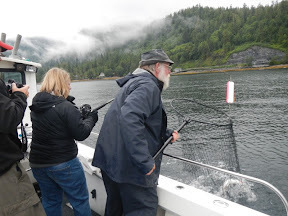
And here’s Jane

Tonight we are looking forward to eating in the main dining room, and relaxing at one of the shows on the ship. It looks like the main entertainment is a comedian and that is often fun.
Tomorrow we are looking forward to a day of whale watching, biking, and zip-lining! Stay tuned.
- Posted using BlogPress from my iPad

